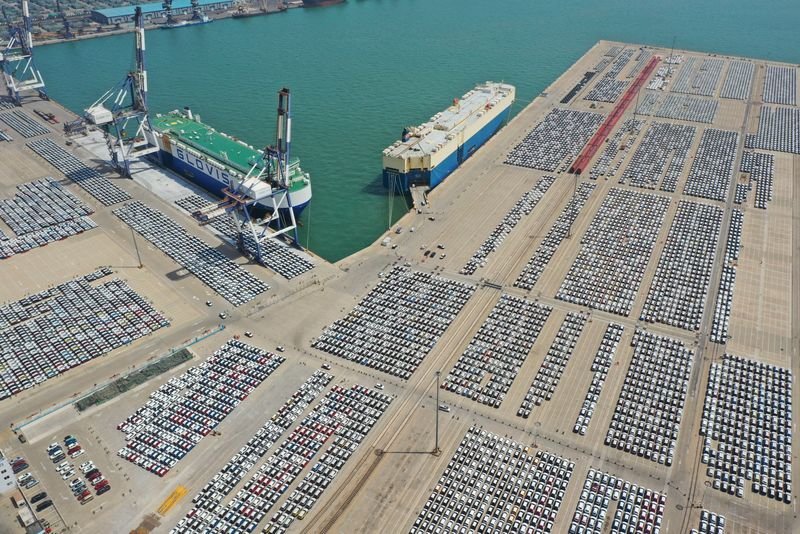By Ellen Zhang and Marius Zaharia
BEIJING/HONG KONG (Reuters) – When Kris Lin, who owns a lighting factory in China, received this year’s first order from a close overseas client, he faced a distressing choice: take it at a loss, or tell workers not to come back after the Lunar New Year.
“It was impossible for me to lose this order,” said Lin, who plans to re-start his factory in the eastern city of Taizhou at around half its capacity after the Feb. 10-17 holiday break.
“I could have lost this client forever, and it would have endangered livelihoods for so many people. If we delay resuming production, people might start doubting our business. If rumours spread, it affects the decisions of our suppliers.”
Prolonged factory deflation is threatening the survival of smaller Chinese exporters who are locked in relentless price wars for shrinking business as higher interest rates abroad and rising trade protectionism squeeze demand.
Producer prices have been falling for 15 straight months, crushing profit margins to the point where industrial output and jobs are now at risk and compounding China’s economic woes, which include a property crisis and debt crunch.
About 180 million people work in export-related jobs, commerce ministry data from 2022 shows.
Raymond Yeung, chief China economist at ANZ, says fixing deflation should be a higher policy priority than reaching the expected growth target of around 5% for this year.
“Companies cut product prices, then staff salaries. Then consumers won’t buy – this could be a vicious cycle,” he said.
Profits at China’s industrial firms fell 2.3% last year, adding to the 4% drop in COVID-hit 2022. An official survey showed manufacturing activity contracting for a fourth straight month in January, while export orders shrank for a 10th month.
For Lin, that has meant the $1.5 million order his client placed was 25% below a similar one last year. It was 10% below production cost.
Sluggish exports mean policymakers need to pull other levers to reach their growth target, increasing the urgency of stimulating household consumption, analysts say.
“The more ‘rebalanced’ growth is, the faster that downward pressure on prices and margins will dissipate,” said Louis Kuijs, Asia-Pacific chief economist at S&P Global.
‘RAT RACE’
China has been funnelling financial resources into the manufacturing sector, rather than consumers, exacerbating overcapacity and deflation concerns, even in booming higher-end sectors, such as electric vehicles.
An executive at an automotive moulds factory from the eastern Zhejiang province, who asked not to be named due to the sensitivity of the matter, expects the firm’s output and exports to rise, but earnings to fall, describing the intensifying competition in the industry as a “rat race.”
As China’s central bank unleashes liquidity into the financial system to spur growth, banks are chasing factories with cheap loan offers.
But squeezed out by bigger rivals, smaller firms are unwilling to take on loans to finance new business, in what economists see as a broken link in China’s increasingly inefficient monetary policy.
Investment by private companies, which according to state officials provide 80% of urban jobs, dropped 0.4% last year, while state investment rose 6.4%.
“Many bank managers call me and they sound very anxious when they can’t lend money,” said Miao Yujie, an e-commerce clothing exporter.
Even after halving his workforce to about 20 people last year, he cannot turn a profit as bigger firms elbow him out of the market.
“But you only need to borrow when you want to expand,” said Miao, adding he mulls closing his business.
THIS TIME IS DIFFERENT
China also went through a deflationary scare in 2015, when it faced overcapacity in primary industries, such as steel, dominated by state-owned enterprises. Authorities downsized these companies to reduce supply and accelerated infrastructure and property construction to boost demand.
“This time it’s more of a private sector surplus,” said Hwabao Trust economist Nie Wen, singling out electronics, chemicals and machinery makers. These firms employ large numbers of people, a sensitive spot for China’s policymakers.
“It is therefore difficult to shrink supply, so more effort should be made on the demand side this year,” Nie said.
Factory owners say the pressure to cut jobs is intense, even if some are reluctant to do so.
Yang Bingben, whose company makes industrial-use valves in the eastern city of Wenzhou, said he had thought of shutting down the business, but keeps it running as he feels indebted to his workers, most of whom are close to retirement age.
Still, he doesn’t know how long the factory can survive.
“This year will be the best of the next decade,” Yang said.
(Additional reporting by Qiaoyi Li; Graphic by Kripa Jayaram; Editing by Sam Holmes)

















